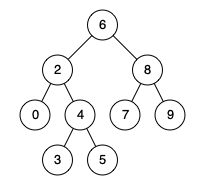原文链接: https://leetcode-cn.com/problems/lowest-common-ancestor-of-a-binary-search-tree
英文原文
Given a binary search tree (BST), find the lowest common ancestor (LCA) of two given nodes in the BST.
According to the definition of LCA on Wikipedia: “The lowest common ancestor is defined between two nodes p and q as the lowest node in T that has both p and q as descendants (where we allow a node to be a descendant of itself).”
Example 1:

Input: root = [6,2,8,0,4,7,9,null,null,3,5], p = 2, q = 8 Output: 6 Explanation: The LCA of nodes 2 and 8 is 6.
Example 2:

Input: root = [6,2,8,0,4,7,9,null,null,3,5], p = 2, q = 4 Output: 2 Explanation: The LCA of nodes 2 and 4 is 2, since a node can be a descendant of itself according to the LCA definition.
Example 3:
Input: root = [2,1], p = 2, q = 1 Output: 2
Constraints:
- The number of nodes in the tree is in the range
[2, 105]. -109 <= Node.val <= 109- All
Node.valare unique. p != qpandqwill exist in the BST.
中文题目
给定一个二叉搜索树, 找到该树中两个指定节点的最近公共祖先。
百度百科中最近公共祖先的定义为:“对于有根树 T 的两个结点 p、q,最近公共祖先表示为一个结点 x,满足 x 是 p、q 的祖先且 x 的深度尽可能大(一个节点也可以是它自己的祖先)。”
例如,给定如下二叉搜索树: root = [6,2,8,0,4,7,9,null,null,3,5]

示例 1:
输入: root = [6,2,8,0,4,7,9,null,null,3,5], p = 2, q = 8 输出: 6 解释: 节点2和节点8的最近公共祖先是6。
示例 2:
输入: root = [6,2,8,0,4,7,9,null,null,3,5], p = 2, q = 4 输出: 2 解释: 节点2和节点4的最近公共祖先是2, 因为根据定义最近公共祖先节点可以为节点本身。
说明:
- 所有节点的值都是唯一的。
- p、q 为不同节点且均存在于给定的二叉搜索树中。
通过代码
高赞题解
解题思路
一、非递归解决
这题让求二叉搜索树的最近公共祖先,而二叉搜索树的特点就是 左子树的所有节点都小于当前节点,右子树的所有节点都大于当前节点,并且每棵子树都具有上述特点,所以这题就好办了,从更节点开始遍历
如果两个节点值都小于根节点,说明他们都在根节点的左子树上,我们往左子树上找
如果两个节点值都大于根节点,说明他们都在根节点的右子树上,我们往右子树上找
如果一个节点值大于根节点,一个节点值小于根节点,说明他们他们一个在根节点的左子树上一个在根节点的右子树上,那么根节点就是他们的最近公共祖先节点。
画个图看一下,比如要找0和5的最近公共祖先节点,如下图所示

public TreeNode lowestCommonAncestor(TreeNode root, TreeNode p, TreeNode q) {
//如果根节点和p,q的差相乘是正数,说明这两个差值要么都是正数要么都是负数,也就是说
//他们肯定都位于根节点的同一侧,就继续往下找
while ((root.val - p.val) * (root.val - q.val) > 0)
root = p.val < root.val ? root.left : root.right;
//如果相乘的结果是负数,说明p和q位于根节点的两侧,如果等于0,说明至少有一个就是根节点
return root;
}
看一下运行结果

二、递归解决
也可把它改为递归的方式
public TreeNode lowestCommonAncestor(TreeNode root, TreeNode p, TreeNode q) {
//如果小于等于0,说明p和q位于root的两侧,直接返回即可
if ((root.val - p.val) * (root.val - q.val) <= 0)
return root;
//否则,p和q位于root的同一侧,就继续往下找
return lowestCommonAncestor(p.val < root.val ? root.left : root.right, p, q);
}
如果嫌代码行数太多,那就一行解决
public TreeNode lowestCommonAncestor(TreeNode root, TreeNode p, TreeNode q) {
return (root.val - p.val) * (root.val - q.val) <= 0 ? root : lowestCommonAncestor(p.val < root.val ? root.left : root.right, p, q);
}
三、参照236. 二叉树的最近公共祖先
这题和第 236 题不一样的地方,在于 236 题不是二叉搜索树,所以第 236 题不能使用上面的方法解决,但这题可以使用第 236 题的解法,这里也可以来看下第 236 题之前写过的题解 236. 二叉树的最近公共祖先
public TreeNode lowestCommonAncestor(TreeNode cur, TreeNode p, TreeNode q) {
if (cur == null || cur == p || cur == q)
return cur;
TreeNode left = lowestCommonAncestor(cur.left, p, q);
TreeNode right = lowestCommonAncestor(cur.right, p, q);
//如果left为空,说明这两个节点在cur结点的右子树上,我们只需要返回右子树查找的结果即可
if (left == null)
return right;
//同上
if (right == null)
return left;
//如果left和right都不为空,说明这两个节点一个在cur的左子树上一个在cur的右子树上,
//我们只需要返回cur结点即可。
return cur;
}
统计信息
| 通过次数 | 提交次数 | AC比率 |
|---|---|---|
| 184585 | 276724 | 66.7% |
提交历史
| 提交时间 | 提交结果 | 执行时间 | 内存消耗 | 语言 |
|---|
相似题目
| 题目 | 难度 |
|---|---|
| 二叉树的最近公共祖先 | 中等 |
| 最小公共区域 | 中等 |




